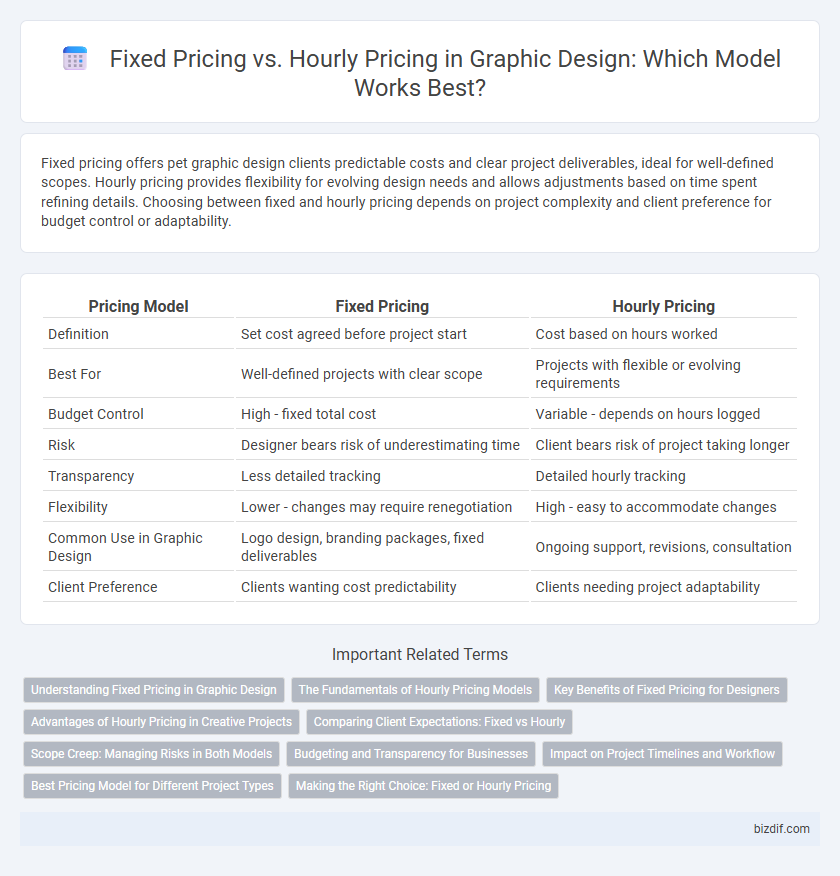Fixed pricing offers pet graphic design clients predictable costs and clear project deliverables, ideal for well-defined scopes. Hourly pricing provides flexibility for evolving design needs and allows adjustments based on time spent refining details. Choosing between fixed and hourly pricing depends on project complexity and client preference for budget control or adaptability.
Table of Comparison
| Pricing Model | Fixed Pricing | Hourly Pricing |
|---|---|---|
| Definition | Set cost agreed before project start | Cost based on hours worked |
| Best For | Well-defined projects with clear scope | Projects with flexible or evolving requirements |
| Budget Control | High - fixed total cost | Variable - depends on hours logged |
| Risk | Designer bears risk of underestimating time | Client bears risk of project taking longer |
| Transparency | Less detailed tracking | Detailed hourly tracking |
| Flexibility | Lower - changes may require renegotiation | High - easy to accommodate changes |
| Common Use in Graphic Design | Logo design, branding packages, fixed deliverables | Ongoing support, revisions, consultation |
| Client Preference | Clients wanting cost predictability | Clients needing project adaptability |
Understanding Fixed Pricing in Graphic Design
Fixed pricing in graphic design offers clients a clear budget by setting a predetermined cost for the entire project, eliminating billing surprises. This approach is ideal for well-defined projects with specific deliverables, allowing designers to streamline workflows and enhance efficiency. Understanding fixed pricing empowers clients to evaluate proposals based on value and scope rather than fluctuating hourly rates.
The Fundamentals of Hourly Pricing Models
Hourly pricing models in graphic design charge clients based on the total hours spent on a project, providing transparency and flexibility for both parties. These models require accurate time tracking and clear communication to prevent scope creep and ensure fair compensation. Understanding hourly rates, project complexity, and potential revisions are fundamental for effective budget management and client satisfaction.
Key Benefits of Fixed Pricing for Designers
Fixed pricing offers designers predictable income and simplifies project budgeting by setting clear financial expectations upfront. This model enhances client trust through transparent, agreed-upon costs, reducing disputes over billing hours. Fixed pricing encourages efficient workflow and creative focus, allowing designers to allocate time strategically without the pressure of hourly tracking.
Advantages of Hourly Pricing in Creative Projects
Hourly pricing in graphic design ensures fair compensation for the actual time and effort invested in complex creative projects, accommodating revisions and evolving client needs without scope limitations. This flexible model incentivizes detailed craftsmanship and fosters transparent communication between designers and clients, aligning payment with the dynamic creative process. Hourly rates also mitigate risks of underestimation, protecting designers from potential losses on projects with unpredictable requirements or extended timelines.
Comparing Client Expectations: Fixed vs Hourly
Fixed pricing offers clients a clear budget upfront, eliminating surprises and fostering trust through defined project scopes, while hourly pricing provides flexibility to accommodate evolving project requirements but may lead to uncertainty in total costs. Clients preferring fixed pricing often expect a well-outlined deliverable and timeline, whereas hourly pricing clients anticipate ongoing communication and transparency regarding hours logged. Understanding these expectations helps graphic designers tailor their proposals to client needs, balancing clarity and adaptability.
Scope Creep: Managing Risks in Both Models
Scope creep poses significant challenges in graphic design pricing models, with fixed pricing risking undervaluation if project requirements expand unexpectedly, leading to potential financial losses. Hourly pricing offers flexibility to manage scope changes dynamically, although it may cause client uncertainty and budget overruns. Effective communication and clear contract terms are essential to mitigate risks and ensure project scope is controlled regardless of the pricing strategy employed.
Budgeting and Transparency for Businesses
Fixed pricing offers businesses clear budgeting with predetermined costs, reducing financial surprises and facilitating project planning. Hourly pricing provides transparency by billing actual time spent, allowing clients to monitor work progress but can create uncertainty in total expenses. Choosing the right model depends on balancing cost predictability and detailed billing visibility tailored to the business's project scope.
Impact on Project Timelines and Workflow
Fixed pricing in graphic design projects offers clearer budget predictability and encourages designers to adhere strictly to established timelines, promoting efficient workflow management. Hourly pricing provides flexibility to accommodate changes or additional requests but can lead to extended project durations and less control over deadlines. Choosing between these models significantly impacts project pacing and resource allocation, with fixed pricing incentivizing streamlined processes and hourly pricing supporting adaptive workflows.
Best Pricing Model for Different Project Types
Fixed pricing suits well-defined graphic design projects with clear deliverables and deadlines, providing budget certainty and minimizing scope creep. Hourly pricing is ideal for flexible, iterative projects requiring ongoing revisions, encouraging thorough collaboration and accommodating evolving client needs. Selecting the best pricing model depends on project complexity, timeline, and client preferences, balancing cost predictability with creative flexibility.
Making the Right Choice: Fixed or Hourly Pricing
Choosing between fixed pricing and hourly pricing in graphic design hinges on project scope clarity and flexibility needs. Fixed pricing suits well-defined projects with predictable deliverables, ensuring budget certainty and streamlined client expectations. Hourly pricing offers adaptability for evolving designs or ongoing collaboration, allowing designers to accommodate changes without renegotiating costs.
Fixed Pricing vs Hourly Pricing Infographic

 bizdif.com
bizdif.com